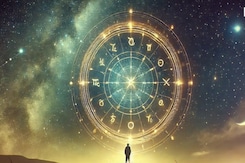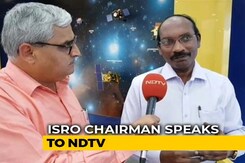Planetary
- All
- News
- Videos
- Web Stories
-

Hubble Captures Rare Collision in Nearby Planetary System, Revealing Violent Planet Formation
- Friday December 19, 2025
Astronomers using NASA’s Hubble Space Telescope have witnessed rare collisions between rocky bodies in the Fomalhaut system. The glowing debris clouds created by these impacts offer a unique glimpse into how planets form and highlight challenges in identifying true exoplanets.
-
 www.gadgets360.com
www.gadgets360.com
-

Earth’s Atmosphere Has Been Leaking Onto the Moon for Billions of Years, Study Finds
- Tuesday December 16, 2025
Earth’s atmosphere has been leaking atoms and molecules to the moon for billions of years, preserving a historical record and potential resources for future lunar missions.
-
 www.gadgets360.com
www.gadgets360.com
-

New Orbital Clues Reveal How Hot Jupiters Moved Close to Their Stars
- Tuesday December 16, 2025
Researchers reveal some hot Jupiters drifted inward smoothly through protoplanetary disks, offering clues to planetary system formation and stability.
-
 www.gadgets360.com
www.gadgets360.com
-

JWST Detects Thick Atmosphere on Ultra-Hot Rocky Exoplanet TOI-561 b
- Sunday December 14, 2025
Astronomers using the James Webb Space Telescope have discovered compelling evidence of a thick atmosphere surrounding TOI-561 b, an ultra-hot rocky exoplanet orbiting its star every 11 hours. Despite extreme radiation and molten surface conditions, the planet appears cooler than expected, suggesting heat-redistributing atmospheric winds and volati...
-
 www.gadgets360.com
www.gadgets360.com
-

Uranus and Neptune May Be Rock-Dominated Planets, Study Suggests
- Saturday December 13, 2025
Uranus and Neptune may not be true ice giants after all. New research using advanced hybrid simulations suggests the distant planets could be dominated by rocky material rather than water-rich ices. The findings challenge decades of planetary models and may help explain the planets’ unusual, non-dipolar magnetic fields. Scientists say future dedi...
-
 www.gadgets360.com
www.gadgets360.com
-

Uranus and Neptune May Be Rocky Worlds Not Ice Giants, New Research Shows
- Thursday December 11, 2025
A new analysis challenges decades-old assumptions about Uranus and Neptune, revealing that both planets may contain far more rock than icy materials. These findings help explain their strange magnetic fields and show that traditional "ice giant" models may be incomplete. Scientists say only dedicated future missions can uncover the true interior ma...
-
 www.gadgets360.com
www.gadgets360.com
-

TRAPPIST-1e Methane Signal Likely False, Webb Data Suggests Airless Planet
- Thursday December 11, 2025
The TRAPPIST-1 planetary system, located about 39 light-years from Earth, hosts seven rocky worlds orbiting a cool red dwarf star. While several of these Earth-sized planets lie in the star’s habitable zone, new observations from the James Webb Space Telescope suggest their atmospheres may be too thin to support life. Earlier hints of methane aro...
-
 www.gadgets360.com
www.gadgets360.com
-

Top 10 Travel Destinations Indians Searched On Google In 2025
- Friday December 5, 2025
- Travel |
From spiritual gatherings like Maha Kumbh to serene beaches in the Philippines and cultural gems such as Georgia, these destinations defined the travel aspirations of Indian travellers in 2025.
-
 www.ndtv.com/travel
www.ndtv.com/travel
-

Red Planet Day 2025: Why November 28 Marks A Landmark Moment In Mars Exploration
- Friday November 28, 2025
- Education |
Red Planet Day 2025: Red Planet Day reminds us how a single spacecraft, Mariner 4, transformed humanity's understanding of Mars and opened a new era of planetary exploration.
-
 www.ndtv.com/education
www.ndtv.com/education
-

Mars Orbiter Tracks Interstellar Comet 3I/ATLAS With Unprecedented Precision
- Tuesday November 18, 2025
Scientists mapped the path of interstellar comet 3I/ATLAS with ten times greater accuracy using images from ESA’s Mars orbiter. The breakthrough shows how observations from different points in space can improve future planetary defense. The data, the first of its kind from another planet’s orbit, offers a powerful new tool for tracking fast-mov...
-
 www.gadgets360.com
www.gadgets360.com
-

AI-Assisted Study Finds No Evidence of Liquid Water in Mars’ Seasonal Dark Streaks
- Friday November 14, 2025
A large-scale AI analysis of more than two million Mars orbiter images shows that the planet’s dark slope streaks form through seasonal dust avalanches, not flowing briny water. The results settle a long-running debate, revealing that wind-driven dust activity shapes Mars’ surface and offering new insights into the planet’s climate past and e...
-
 www.gadgets360.com
www.gadgets360.com
-

Astronomers Spot First Coronal Mass Ejection from a Distant Star, Raising Questions About Planetary Habitability
- Monday November 17, 2025
Astronomers detected the first coronal mass ejection from a distant star, revealing that powerful stellar eruptions may strip atmospheres from nearby planets, affecting exoplanet habitability and the search for life.
-
 www.gadgets360.com
www.gadgets360.com
-

Hubble Captures Rare Collision in Nearby Planetary System, Revealing Violent Planet Formation
- Friday December 19, 2025
Astronomers using NASA’s Hubble Space Telescope have witnessed rare collisions between rocky bodies in the Fomalhaut system. The glowing debris clouds created by these impacts offer a unique glimpse into how planets form and highlight challenges in identifying true exoplanets.
-
 www.gadgets360.com
www.gadgets360.com
-

Earth’s Atmosphere Has Been Leaking Onto the Moon for Billions of Years, Study Finds
- Tuesday December 16, 2025
Earth’s atmosphere has been leaking atoms and molecules to the moon for billions of years, preserving a historical record and potential resources for future lunar missions.
-
 www.gadgets360.com
www.gadgets360.com
-

New Orbital Clues Reveal How Hot Jupiters Moved Close to Their Stars
- Tuesday December 16, 2025
Researchers reveal some hot Jupiters drifted inward smoothly through protoplanetary disks, offering clues to planetary system formation and stability.
-
 www.gadgets360.com
www.gadgets360.com
-

JWST Detects Thick Atmosphere on Ultra-Hot Rocky Exoplanet TOI-561 b
- Sunday December 14, 2025
Astronomers using the James Webb Space Telescope have discovered compelling evidence of a thick atmosphere surrounding TOI-561 b, an ultra-hot rocky exoplanet orbiting its star every 11 hours. Despite extreme radiation and molten surface conditions, the planet appears cooler than expected, suggesting heat-redistributing atmospheric winds and volati...
-
 www.gadgets360.com
www.gadgets360.com
-

Uranus and Neptune May Be Rock-Dominated Planets, Study Suggests
- Saturday December 13, 2025
Uranus and Neptune may not be true ice giants after all. New research using advanced hybrid simulations suggests the distant planets could be dominated by rocky material rather than water-rich ices. The findings challenge decades of planetary models and may help explain the planets’ unusual, non-dipolar magnetic fields. Scientists say future dedi...
-
 www.gadgets360.com
www.gadgets360.com
-

Uranus and Neptune May Be Rocky Worlds Not Ice Giants, New Research Shows
- Thursday December 11, 2025
A new analysis challenges decades-old assumptions about Uranus and Neptune, revealing that both planets may contain far more rock than icy materials. These findings help explain their strange magnetic fields and show that traditional "ice giant" models may be incomplete. Scientists say only dedicated future missions can uncover the true interior ma...
-
 www.gadgets360.com
www.gadgets360.com
-

TRAPPIST-1e Methane Signal Likely False, Webb Data Suggests Airless Planet
- Thursday December 11, 2025
The TRAPPIST-1 planetary system, located about 39 light-years from Earth, hosts seven rocky worlds orbiting a cool red dwarf star. While several of these Earth-sized planets lie in the star’s habitable zone, new observations from the James Webb Space Telescope suggest their atmospheres may be too thin to support life. Earlier hints of methane aro...
-
 www.gadgets360.com
www.gadgets360.com
-

Top 10 Travel Destinations Indians Searched On Google In 2025
- Friday December 5, 2025
- Travel |
From spiritual gatherings like Maha Kumbh to serene beaches in the Philippines and cultural gems such as Georgia, these destinations defined the travel aspirations of Indian travellers in 2025.
-
 www.ndtv.com/travel
www.ndtv.com/travel
-

Red Planet Day 2025: Why November 28 Marks A Landmark Moment In Mars Exploration
- Friday November 28, 2025
- Education |
Red Planet Day 2025: Red Planet Day reminds us how a single spacecraft, Mariner 4, transformed humanity's understanding of Mars and opened a new era of planetary exploration.
-
 www.ndtv.com/education
www.ndtv.com/education
-

Mars Orbiter Tracks Interstellar Comet 3I/ATLAS With Unprecedented Precision
- Tuesday November 18, 2025
Scientists mapped the path of interstellar comet 3I/ATLAS with ten times greater accuracy using images from ESA’s Mars orbiter. The breakthrough shows how observations from different points in space can improve future planetary defense. The data, the first of its kind from another planet’s orbit, offers a powerful new tool for tracking fast-mov...
-
 www.gadgets360.com
www.gadgets360.com
-

AI-Assisted Study Finds No Evidence of Liquid Water in Mars’ Seasonal Dark Streaks
- Friday November 14, 2025
A large-scale AI analysis of more than two million Mars orbiter images shows that the planet’s dark slope streaks form through seasonal dust avalanches, not flowing briny water. The results settle a long-running debate, revealing that wind-driven dust activity shapes Mars’ surface and offering new insights into the planet’s climate past and e...
-
 www.gadgets360.com
www.gadgets360.com
-

Astronomers Spot First Coronal Mass Ejection from a Distant Star, Raising Questions About Planetary Habitability
- Monday November 17, 2025
Astronomers detected the first coronal mass ejection from a distant star, revealing that powerful stellar eruptions may strip atmospheres from nearby planets, affecting exoplanet habitability and the search for life.
-
 www.gadgets360.com
www.gadgets360.com

































